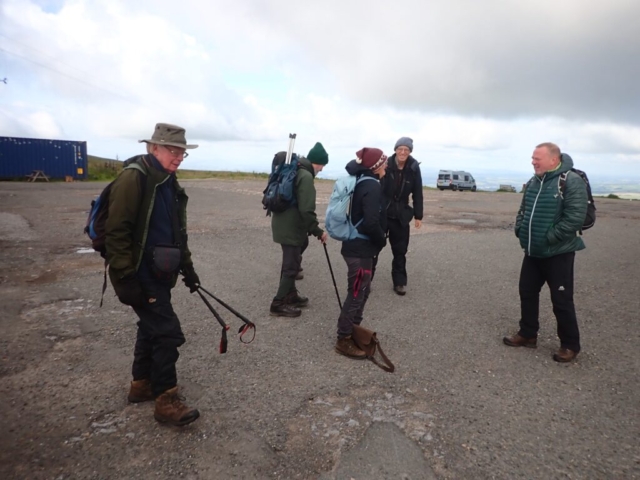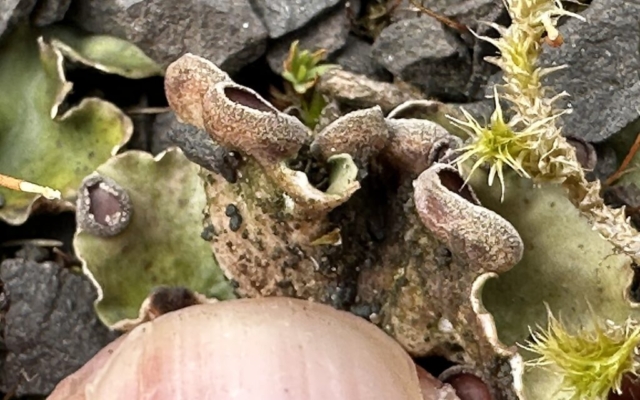Peltigeratastic Hartside!
Hartside Pass stands at 580m (1904 feet) above sea level. There are cracking views over the Eden Valley to the Lake District Fells and across the Solway to Criffel beyond Dumfries. You can see the weather coming in. And that’s where we gathered, a week after we were meant to (blame the weather forecast) and 5 years after the café burnt down. It was July and most of us wore winter hats.
After a short journey down the road (and an admire of the Lady’s Bedstraw) we veered off on a track towards the old Barytes mine. A gate with fine growths of Parmelia sulcata and Ochrolechia androgyna detained us for a little while: there was noticeably less lichen growth around the impressive nail heads in the top rail. The first concrete buildings had good growths of Collema auriforme and Collema crispum, together with nesting swallows.
A further building provided even more distraction: there was Bilimbia sabuletorum and Agonimia tristicula on the mosses; Aspicilia contorta and bright growths of Caloplaca flavovirescens, Leptogium gelatinosum and Collema cristatum among others on the concrete roofs. The sun shone briefly, matching the only Xanthoria parietina we saw all day. And then we headed down into the mine valley proper, towards where Caz and Chris had done a recce earlier in the month.
There were boulders, grassy and mossy patches and shaly mine spoil terraces, interspersed with steep slopes and little outcrops. There was limestone and sometimes sandstone, together with some obviously mineralised boulders. We leapfrogged from substrate to substrate, ticking off Cetraria muricata, then C. aculeata; Cladonia furcata then C. gracilis and C. potentosa. Rabbit droppings provided some entertainment and interest: there were fungal fruiting bodies, but were they lichenised? Samples were taken- just in case. Wooden posts had Hypocenomyce scalaris, Hypogymina physodes and tubulosa, a variety of Cladonias. “Do you want to see my other rabbit dropping?” asked Chris.
And so to lunch. And the Peltigeras. There was P. hymenina and lots of P. membranacea. The reddish looking tomentose one was P. rufescens and the one that looked a bit like P. membranacea but had curly rhizines like the hair on a Belted Galloway must have been P. canina. There was P. neckeri, with black (or at least dark) apothecia. Underneath it is strikingly dark in the middle, and has dramatic white “net holes” between the veins. Peltigera didactyla was new to me, the younger lobes having a lovely pattern of soredia. P. venosa was new too, a lovely greeny colour and dramatically fertile. Caz pointed out the rounded cephalodia on the underside. It seemed confined to a particular level of small shaly waste. Searches elsewhere drew a blank.
“Have you seen any P. leucophlebia here?” Asked David. “Cos there’s lots lower down the beck.” Within a couple of minutes he had found some amongst the moss. And the more we looked, the more we found, bright green from the recent rains, and half buried among the mosses.
As the rains came in, we headed down a little, to where there were more acid-rock loving species like Parmelia omphalodes on the boulders. The shaly terrace didn’t reveal any more venosa. But there was a lovely underhang with lots of Diploschistes scruposus on rock, Dibaeis baeomyces and Trapeliopsis pseudogranulosa on the soil.
An old metal mine bogey provided some puzzles. Rhizocarpon oederi was identified, and whilst we wanted the sorediate Lecanora to be L. handelii it was probably L. soralifera. A lovely mine arch detained us for a few minutes; there was Peltigera praetextata (at last!) above it on some concrete; Gyalecta jenenis on a limestone boulder and Cladonia pocillum on moss. Chris found Lichenomphalia alpina, a bright yellow hi-vis mushroom shining out of the turf. And with that, and the weather looking to close in, we trudged up towards the cars.
Our list wasn’t that long, but it’s a very interesting site, with the variety of substrates giving a wide range of mainly terricolous and saxicolous lichens. Further explorations would no doubt reveal a lot more. And someone very knowledgeable could make a long list! The Peltigera venosa was a real find, and it would be worth making further explorations of other terraces to see if there is more. Unfortunately, the vegetation growth on the terraces and tree plantings around the site probably mean its days are numbered.
Text: Pete Martin. Photos: Chris Cant, David Clarke, Geoffrey Haigh, Pete Martin, Caz Walker























